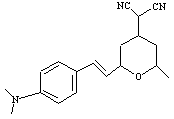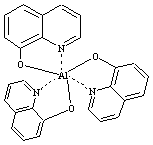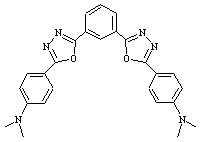The main problem with liquid crystal and plasma technologies is that they rely on backlighting to produce an image. Using materials that emit on their own is a solution to the problem. Organic materials have the advantages of having bright, efficient emission, available in all three primary colours, as well as being cheap and reliable. A scalable emissive area - from a few micro meters to a few cm in size combined with low voltage operation and a viewing angle of more than 160 degrees is achievable from these emissive devices. At the moment the most successful emissive displays are made from relatively small metal complexes containing organic ligands but the future points towards the less expensive and more efficient prospect of organic polymers (long chain molecules). The Japanese government recently formed a £25 million consortium of 12 companies and 4 universities specifically to develop 60-inch flat screens using organic LED technology as well as roll-up and flexible screens. The world market for organic LEDs is at present estimated at £65 million by the manufacurer Covion [16] but is expected to grow by a factor of 25 in the next 4 years. Full colour displays such as the one developed by Kodak in figure 6 seem to be the future of the flat screen.
At present organic materials are used in small devices such as phones and PDAs but there is no significant limiting factor for the development of huge displays once technology has been optimised.
Semiconductors [17]The crucial factor in forming light emitting devices is the ability of the organic material to conduct electricity. Conventional light emitting diodes contain silicon which behaves like a metal in its conduction properties, i.e. it will conduct electricity like a wire. This is due to the inherent atomic properties of a material. Atomic orbitals containing the valence electrons, those involved in bonding, can overlap with other orbitals on neighbouring atoms which have similar symmetry to form hybrid or molecular orbitals.
In a metal such as sodium which contains one valence, or bonding, electron in a 3s-orbital when there will be N molecular orbitals formed from the overlap of N 3s-orbitals where the sample contains N atoms. Some of these new molecular orbitals will be antibonding and some bonding depending on the symmetry of their overlap. For sodium ½N molecular orbitals are filled as each orbital can hold 2 electrons. As these molecular orbitals are very close in energy they appear to be one continuous band rather than discrete orbitals. The full orbitals make up the valence band and the empty ones the conduction band. In a metal there is little gap between these two bands so electrons can move easily between them. As a net flow of electrons constitutes a current this means a metal conducts. In an insulator there is a large space where there are no orbitals called a band gap. Electrons are not energetic enough to overcome this gap and as such are immobilized and current cannot flow. In a semiconductor electrons need to gain energy from heating the solid in order to “jump” the band gap. Therefore conversely to a metal conductivity increases with temperature.
Doping to control colour of emissionAdding small amounts of other materials can improve the efficiency of emission as well as enable its colour to be fine-tuned. If the dopant molecule which is added traps electrons then this withdraws atoms from the filled band and puts them in a new acceptor band leaving holes in the valence band. This is the case in the doping of silicon with gallium. Gallium, has fewer valence electrons, 3, than silicon which has 4 so electrons will favour movement into the acceptor band.
The reverse occurs when the dopant contain more electrons than the material they are doping leading to donation from a donor band to the previously empty conduction band. This is the case for the addition of phosphorus with 5 valence electrons to silicon. Energy transfer processes to the dopant molecule causes emission at a different wavelength as can be seen in the Figure 9
[20] where DCM-2 is used to move the emission colour from green to red as its relative proportion within the organic layer increases changing the band structure of the Alq3. This ability to "tune" emission easily is another of the advantages of organic materials.
Organic LEDS
These are based on inorganic LEDs such as gallium arsenide where two layers doped to have different electrical characteristics are interconnected. [21]. One layer acts as an anode and the other a cathode. When electricity passes through the device electrons move towards the positive electrode and holes, the spaces where electrons would be, move in the opposite direction. Where the charges meet at the junction of the two substances they combine to give off light forming a new particle, an exciton which releases a photon of light. The colour of light emitted depends on the properties of both semiconductor and its dopants. Unlike in gallium arsenide where LEDs cannot be crafted larger than the crystal wafers, from which they are fabricated, can be grown organic films have the advantage of being able to be laid over unlimited extents.
Small molecules in emissive displays [22]
These mainly consist of group II and III metals, such as aluminium, bonded to aromatic ligands. These are ligands which contain conjugated bonds or high electron density regions.
One of the most familiar of these is Aluminium tris(hydroxyquinolate) or Alq3 (see table 1) which is the green backlight for LCDs in mobile phones. To get a full colour display it is necessary to either have three different molecules in each of the three primary colours combining in different amounts or to have one molecule emitting over the whole spectrum and use filters to get the desired colour. The first possibility is achieved by substituting aluminium quinolates like Alq3 in order to get different colours of emission. The second possibility could occur with zinc chelate molecules, but these unfortunately don’t quite emit over the complete visible spectrum. Their emission is also of variable quality often with various unwanted hues and tints being present. A combination of at least two whole spectrum emitters needs to be used in order to overcome this problem.
History and Development [23]
In 1987 Tang reported one of the first efficient small molecule emissive devices emitting green and orange light. A thin organic film of thickness of 10nm consisting of a mixture of Alq3 and diamine was sandwiched between an anode made from, indium-tin oxide (ITO) and a cathode made from a magnesium-silver alloy. The Alq3 has a high LUMO (lowest unoccupied molecular orbital) acting as an effective electron transport layer and the diamine a low HOMO (highest occupied molecular orbital) and therefore a good hole transporter. Carrier injection into the organic layer occurs easily as the LUMO-LUMO gap between Alq3 and diamine is large and the HOMO gap small so recombination takes place at the interface between the two organics. By 1996 Jenekhe et al. had produced a diode consisting of two joined organic layers which showed a variance in emission colour with different voltages [24].Table1: Small Molecule Emitters [23]
570-620Stacked devices operating independently combining three separate devices each of a different colour were reported by Stephen Forest et al at Princeton as early as 1997 [25] but high cost and complicated fabrication have kept this technology at development stage. Recently a few boron containing polymers and small molecules have been used in emissive devices [26]. Because boron forms more covalent bonds with its ligands the compounds are far more stable. Emission from one of these complexes LiBq4 (see table 1) is blue shifted relative to Al complexes, this is one of the best reported blue emitters found so far. Nowadays several tens of thousands of organic LEDs are manufactured, mainly under licence from Eastman Kodak.
Problems do still exist however; the depositing of molecules is carried out at high temperatures and vacuums in batches. This is fine for monochrome emitters but laborious for full colour devices, as adjustments must be made before the depositing of each of the primary colours. This is also quite expensive and consequently size limiting. At the moment organic small-molecule LEDs are about as bright as a household light bulb and last up to ten times longer but are still only suitable for use in handheld devices and in the panels on microwaves. Dimness and inefficiency are limiting factors but this is being addressed. Dodabalapur at Bell laboratories has used reflective mirrors to trap emitted light within a cavity and thus produce an amplified beam of greater intensity with minimised losses. Stray beams of light are not allowed to escape adding to the intensity of the emergent light.4.5 Conjugated polymers in displays
How can plastic conduct?We are used to plastic not conducting electricity; after all you don't get an electric shock from touching the plastic coated wire on your toaster because this material, a polymer, is an insulator. However several types of polymer do conduct like metals. The relative conductivity of these conjugated polymers can be seen below. [27]
The presence along the polymer's backbone of conjugated double bonds is what allows it to be conductive. This conjugation occurs when the bonds between carbons in a long chain alternate between being single and double. Each double bond contains a slightly delocalized pi-bond in addition to a stronger sigma-bond. These pi-bonds mix giving a region of high electron density at right angles to the direction of the p-orbitals on individual carbon atoms. This allows the movement of electrons along the chain and thus conductivity. This discovery and subsequent development of these polymer emitters won the 2000 Nobel Prize for Alan Heeger, Alan Mac Diarmid and Hideki Shirakawa. In addition several companies have started exclusively for the development of this technology, the most successful that Jeremy Burroughs, Richard Friend et al, set up Cambridge Display Technology, CDT, a spin off from their research at Cambridge University. The properties of polymers especially their easy processing, flexibility and toughness in addition to emissive and conductive properties made this new class of polymers very desirable.
How were these materials discovered?[28 ]
In the early 1970s Shirakawa was working on the synthesis of polyacetylene[29] when an excess of catalyst was added to the reaction mixture producing an unexpected silvery film. This prompted collaboration with MacDiarmid and Heeger to further investigate the possibilities of this new material. A very important discovery, that the addition of iodine causes an increase in conductivity by a factor of several million was noted in 1977. [30]
Further work by Friend et al at the Cavendish laboratory in Cambridge, found that a different polymer PPV (see table 2) glowed a green-yellow colour when voltage was applied. By 1990 LEDs using polymers were as bright as a fluorescent strip light and by varying the structure of PPV a whole range of colours could be achieved. These polymers are used in devices similar to those containing small-molecule emitters with a hole-injecting cathode of ITO and electron-injecting anode of aluminium, magnesium or calcium sandwiching the polymer layer.[30] Devices use a variety of different polymers which emit at different wavelengths and as such appear different colours. Some of these can be seen in table 2. The effect of adding different groups to a polymers backbone can be seen when comparing PPV and MEH-PPV where a change in the side-groups of the polymer causes a change in emission colour from green to red. Another way of changing emission colour is to use a blend of either two polymers or a polymer and another molecule. This affects the spacing between energy levels and consequently the emission colour
Table 2: Light emitting polymers [31 ]
Acronym Colour Molecular Structure Max wavelength/nm However these devices have a lifetime of just a few hundred hours much shorter than the ideal 2000-10000 hours. Only 4% of the current passed into these polymer LEDs is converted to light a long way off the efficiency of the other more developed display technologies.
How do you synthesise these polymers?The methods of synthesis for these conjugated polymers are all based along the same basic lines. PPV as an example can be made by the Wessling method [32] (below) where the synthetic precursors used is p-Xylylenebis(tetrahydrothiophenium chloride), a commonly available compound which is soluble and
therefore easy to make react. Other methods include using a Wittig reaction where a phosphor-containing compound is used to catalyse the addition of alkene units to form a very long chain molecule. A palladium catalyst can also be used in a reaction known as the Heck reaction.
These methods of synthesis are all relatively easy to perform and, more importantly, easy to adapt. None of the starting materials for these polymerisations are restrictively expensive or harmful; another advantage of the use of these organic displays. The one slight disadvantage is that all these polymers are sensitive to air and water so on making the devices decomposition can occur relatively rapidly.How do you make the devices?
To make devices using small molecule organics vacuum evaporation is used whereas for polymeric materials spin or dip coating techniques are employed. This involves spinning or dipping the glass substrate, on which ITO is deposited, in a solution of the required polymer. The advantages of this method of manufacture over evaporation are manifold and relate to cost. However in order to deposit the metal cathodes high vacuums are required this will make up a significant proportion of manufacturing costs when these devices are commercialised. Alternatives such as plating silver cathodes in air have been successful for groups including those of Miyata and Sakuratani [33].
To make the organic polymer flat screens themselves ink-jet printing of arrays of polymer LEDs [34] has been investigated. It is possible to produce print droplets of 5 micrometers, a factor of 5 smaller than those in conventional printers but reliability and accuracy in this very delicate process both need to be improved.
Other solutions are "stamping" a host polymer with inks that diffuse into the polymer and modify it giving it the required properties. This was used by James Sturm at Princeton in 2002 to print a full-colour display by pushing a rubber stamp of green and red dots onto a blue polymer forming a pattern of emitters which worked successfully to form a display when the polymer sheet was laid over thin array of electrodes.[35]
Looking to the future: Novel uses of polymer LEDs
A partially self-assembling flexible display is the latest idea from a team at Harvard led by Heiko Jacobs [36](left) who have already made cylindrical displays. A cocktail of solder LEDs and copper-coated plastic is mixed up in hot water in this novel technique. The method works due to the adhesion between metals and solder. A sheet of copper squares fabricated onto a flexible polymer sheet is dipped into solder then put into a water-filled vial with LED chips coated in gold. Using a heat gun to melt the solder and shaking adhesion forces give aligned LEDs on the flexible base, 98% of these in the desired place. A transparent layer of electrodes is added and then voila a bendy screen! It has been suggested that roll up presentation screens, electronic posters and even changeable wallpapers will be the logical conclusion to this work. But the question still remains as to whether these technologies have a market to fill.
A hybrid liquid crystalline material which polymerises under the influence of ultraviolet light is another variation on the organic polymer theme under development at the University of Hull [37]. Making pixels one at a time not unlike in the process of making silicon chips is an advantage as in the higher current flow due to the liquid crystal nature of the material. These materials would however probably find their use as brighter backlights for LCDs in phones which make them a slightly different technology to the other polymer devices.





